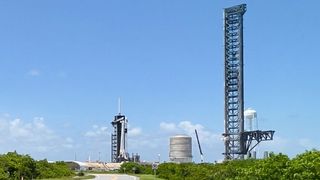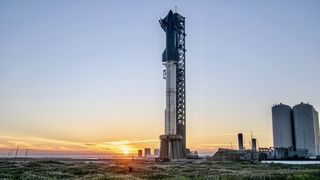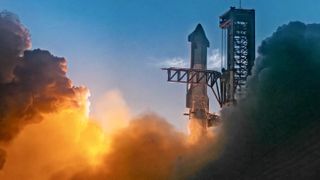SpaceX rivals challenge Starship launch license in Florida over environmental, safety concerns
Elon Musk's SpaceX hopes to launch up to 44 flights of Starship each year.

SpaceX's plans to launch its Starship–Super Heavy two-stage rocket 44 times per year from NASA's Kennedy Space Center in Florida have come under fire from its two main rivals: United Launch Alliance (ULA) and Jeff Bezos' Blue Origin.
The Starship vehicle is the world's largest rocket. Its two stages are SpaceX's Super Heavy booster rocket, and the upper stage spacecraft known somewhat confusingly as Starship or "Ship," on which a crew of up to 100 astronauts could someday fly.
Having undergone testing over the past few years, the design of the Starship/Super Heavy has undergone a number of revamps, with the latest resulting in a rocket that will stand up to 492 feet (150 meters) tall. To put this into context, the Saturn V was 363 feet (111 meters) tall, while the crewed version of NASA's new Space Launch System stands 322 feet 98 meters high. SpaceX's rocket is enormous, and the plan is for it to ferry astronauts to the moon and Mars.
Before SpaceX can get a license to commence launches from launchpad 39A at Kennedy Space Center (KSC) in Florida, an environmental impact statement must be provided that details what effects SpaceX's launches would have on the local environment and wildlife, as well as neighboring business and residents. This is done so by the Federal Aviation Administration (FAA), and it is currently in the consultation phase, where local businesses, organizations and members of the public can provide their say as to the pros and cons of SpaceX's plans. And, well, SpaceX's rivals haven't held back.
Blue Origin submitted a 3-page letter to the FAA, in which they ask for a cap to be put into place on the number of launches and landings, reducing the 44 planned launches to an unspecified amount "that has a minimal impact on the local environment, locally operating personnel and the local community," they wrote.
The Blue Origin objections also raise the point that the Starship–Super Heavy will hold "an unprecedented" 5,200 metric tons of liquid methane fuel, which is highly flammable and, should something go wrong, could create a devastating explosion on the launch pad. Blue Origin claims that the safety margins are so wide that they overlap with the launch pads, hangars and offices of several other companies, including Blue Origin themselves on launch pad 36, all of which are leased from the Kennedy Space Center.
ULA's criticisms hit even harder in a 22-page document that the company submitted as part of the consultation. They don't hold back, accusing SpaceX of producing their own environmental impact statement for their extravagantly named 'Starbase' at Boca Chica in Texas from where they have been testing Starship so far.
Get the Space.com Newsletter
Breaking space news, the latest updates on rocket launches, skywatching events and more!

In the letter, ULA points out that SpaceX's environmental impact statement suggested that debris from any mishap on launch would only cover a square mile (2.5 sq km). In April 2023, during Starship's first test flight, debris was scattered instead over a 6-mile (9.6-km) radius, endangering the surrounding area and showing just how much SpaceX had underestimated the danger to their surroundings. The explosion led to environmental groups bringing a lawsuit against SpaceX and the FAA, which was eventually dismissed in court. At Kennedy, ULA's base is located only 3 miles (4.8 km) from SpaceX's launch pad 39A, which makes them understandably nervous.
"With the increased liftoff thrust planned for Starship, the debris from a similar launch failure could reach larger, populated areas surrounding KSC," said ULA, whose recommendation is that SpaceX launch Starship from Boca Chica instead.
"As the largest rocket in existence," wrote ULA, "an accident would inflict serious or even catastrophic damage, while normal launch operations would have a cumulative impact on structures, launch vehicle hardware and other critical launch support equipment."
On the other hand, Blue Origin suggested that the Government build new launchpads farther away from 39A for those companies such as themselves that could potentially be affected by SpaceX's Starship operations.
There was also much concern for the environment and local wildlife. To achieve the aim of 44 launches per year, there would need to be at least 3 or 4 launches per month, resulting in launchpad 39A being in use year-round. The Merritt Island Wildlife Association (Merritt Island is the peninsula on which the Kennedy Space Center is found) pointed out that floodlights will be on almost all the time at 39A that will disrupt the natural rhythms of wildlife, for example by sending migrating birds astray.

Meanwhile, the Defenders of Wildlife organization in Florida point out that near Boca Chica, the eggs of nesting birds were cracked by falling granular debris resulting from Starship's previous test flights. Birds are known to nest near launch pad 39A, and more frequent launches would harm the bird population in the area. However, the Defenders of Wildlife do state their belief that using 39A is better than building brand-new launch sites on undeveloped ground near Kennedy Space Center, as proposed by Blue Origin, which would also have a great environmental impact.
A wide-ranging New York Times investigation published June 8 details the environmental damage SpaceX's operations at Boca Chica have caused, noting that the damage has sparked a debate "over how to balance technological and economic progress against protections of delicate ecosystems and local communities." While FAA leadership is aware of the environmental issues Starship is causing, the agency has also stressed that the vehicle is vital for America's space program.
"Blowing debris into state parks or national land is not what we prescribed, but the bottom line is no one got hurt, no one got injured," The FAA's Associate Administrator for Commercial Space Transportation Kelvin B. Coleman told the New York Times. "We certainly don't want people to feel like they're bulldozed. But it's a really important operation that SpaceX is conducting down there. It is really important to our civilian space program."
It's not just wildlife that could be affected by Starship. SpaceX's water deluge system sprays a million gallons of water onto the pad during launch to protect it from damage during launch by absorbing much of the heat. While much of this water is vaporized, the rest runs off into collection ponds around the launch site. ULA questions whether and how this water will be treated for any toxic or otherwise hazardous chemicals in it, and what will prevent it from leaking out into the water supply at large.

SpaceX also has their eye on a second launch pad, having inquired about use of launch complex 37 from 2026 onwards on the neighboring Cape Canaveral Space Force Station. The U.S. Air Force is conducting its own environmental study of this proposal before granting permission.
ULA also questions SpaceX's decision to stop using offshore drone ships to land the Super Heavy booster on, and to instead land them back on 39A, which they say "shifts the risks of a system failure onto the communities, businesses, and environment that surround KSC."
All three companies are competing for the same NASA contracts, and some observers might see these complaints as sour grapes from SpaceX's rivals who are struggling to keep up with them. SpaceX's Elon Musk responded in a seemingly mocking fashion to Blue Origin's complaint on social media, posting "Sue Origin" on X (the social media company he owns) in the days following the company's letter.
However, whatever the motivations behind the complaints, many of them relating to safety and environmental impact do seem pertinent. Even NASA have misgivings; space agency officials have previously stated that an incident at the launch pad could effectively cut NASA off from their only means of reaching the International Space Station, which would leave astronauts stranded.
Both Blue Origin's and ULA's objections to Starship operations at KSC come down to the two companies believing that the rocket is too untested, too dangerous and too disruptive to fit into the ecosystem of the other users of the Kennedy Space Center.
However, it will be up to the FAA to decide whether such concerns are valid, and whether they are enough to prevent Elon Musk and SpaceX from fulfilling their Starship dreams.
Join our Space Forums to keep talking space on the latest missions, night sky and more! And if you have a news tip, correction or comment, let us know at: community@space.com.

Keith Cooper is a freelance science journalist and editor in the United Kingdom, and has a degree in physics and astrophysics from the University of Manchester. He's the author of "The Contact Paradox: Challenging Our Assumptions in the Search for Extraterrestrial Intelligence" (Bloomsbury Sigma, 2020) and has written articles on astronomy, space, physics and astrobiology for a multitude of magazines and websites.
-
m4n8tpr8 FAA's non sequitur defense of SpaceX environmental damage far beyond what was foreseen in the self-made environmental impact assessment that was rubberstamped by the FAA, claiming Starship is important for US space ambitions, is a nice example of regulatory capture.Reply -
Unclear Engineer Some of the complaints about environmental impacts seem overblown. For instance, the New York Times "report" included something about "all 9 of the bird nests" in an impacted area at Boca Chica were destroyed by the first flight. But, putting that in context, how many bird nests are destroyed when the average shopping center is built? Probably a lot more than 9.Reply
Similar misrepresentations are being made about the fresh water being used to protect the launch pad. The propellants used in these SpaceX rockets are not really contaminants. But, the kerosene that ULA uses in its Atlas rockets are serious contaminants. And the exhausts of the burned propellants are basically CO2 and water.
The real issues for the Kennedy Space Flight Center are the size of the explosion for a failure on the pad, the potential for an explosive fuel+air mixture if cold methane is spilled in large quantity, and the potential for damage when a reusable vehicle is landing.
At this point, the liquified methane risk is probably being over compensated by the FAA and NASA, and they need to take a look at what is really prudent and what are excessive precautions. We already have sea going ships carrying even more of the same liquified methane material docking and loading/off-loading at port facilities all over the world. Making realistic safety areas is crucial to making proper use of the space flight facilities already there and then deciding if expansions are needed.
And, remember that a landing SuperHeavy booster is not carrying much fuel at all. The explosion potential is not so great for the landing operation. Comparing that risk to the risk of Boeing 737 Max airliners flying low over residential communities as they approach and take off from airports is probably a reasonable basis for making a decision.
But, that requires some data on the reliability of the SpaceX landing practices, which we do not have, yet. And, I agree that experience needs to be gained at Boca Chica before SuperHeavy and StarShip should be allowed to launch and land at the Florida facilities. -
marsgeologist Reply
I would like to see a formal environmental impact study on our planet's ionosphere in regards to punching many large holes as frequently as more than 44 times per year, the results are not as benign as some say they areAdmin said:United Launch Alliance and Blue Origin have cited safety and environmental factors in challenges to SpaceX's launch license for Starship at Kennedy Space Center in Florida.
SpaceX rivals challenge Starship launch license in Florida over environmental, safety concerns : Read more -
Unclear Engineer The study of the atmospheric impact of space launches and re-entries should be done, but not limited to StarShip or SpaceX. If the demand is there, the launches will happen, and it really doesn't matter that much what company or nation is doing it with what rocket. The exhaust gases from most rockets are pretty much water, CO2 and maybe some nitric oxides for the rockets that still use hypergolic fuels. The reentries put all sorts of stuff into the atmosphere.Reply -
gsteele531 Why would we be surprised at scalawags clawing at the seams of royalty in the hopes of gaining a crumb from the King's table? Lawyers vie with fiction writers for the fantasist trophy for whoever can fabricate the most contused, Gordian Knot rationales for obstructing progress.Reply
Meanwhile, others drops rockets out of the sky willy-nilly, trailing brown clouds of toxins. Same story, different day. -
DarthHangry Better pray Elon doesnt call their bluff and threaten to move countries; especially with Starliner stuck in orbit.Reply -
m4n8tpr8 Reply
Where would he move?...DarthHangry said:Better pray Elon doesnt call their bluff and threaten to move countries; especially with Starliner stuck in orbit. -
m4n8tpr8 Reply
That's not how this works.Unclear Engineer said:Some of the complaints about environmental impacts seem overblown. For instance, the New York Times "report" included something about "all 9 of the bird nests" in an impacted area at Boca Chica were destroyed by the first flight. But, putting that in context, how many bird nests are destroyed when the average shopping center is built? Probably a lot more than 9.
First, you can find more detailed reports than NYT's, and those nine nests were a random sample of monitored nests that were checked shortly after the launch (wildlife monitors don't have the funding & capacity for a comprehensive survey of the entire area, nor would it be necessary). And what matters is that all nine nests in that sample were affected (altogether 17 out of 22 eggs broken, and predators will find the rest due to the smell of the broken ones in the same nests), which means that almost all nests in the same radius from the launch site in the protected area must have been destroyed.
Second, even if this had been nine nests after a comprehensive check of the entire area, it could be significant: nine nests of a short-lived common bird with millions of specimens is not the same as a long lifecycle endangered species with only a few hundred birds alive.
Third, even if this had been nine nests in the whole area of a common short-lived bird, "protected area" and "protected species" would have to count for something, it should not be something at the digression of a billion-dollar corporation funded by taxpayer money.
(Also, zooming out to the underlying issue, it should not be rival billion-dollar companies funded by taxpayer money that point these things out and try to effect enforcement but federal and local authorities.) -
Unclear Engineer m4n8tpr8, I do know how this works. Media with biases cherry pick site specific info and conflates it with other generalized info to make things seem worse of better than an objective appraisal would show. The NYT article smacks of that.Reply
Your post has a lot of "ifs" in it. How about some actual facts? What species were those 9 nests - common or rare or endangered? What were their specific distances from the launch pad? What were the actual damages to the various eggs - smashed, cracked, pushed out of nest, what?
More importantly, what was the effect on those or similar nests at similar distances due to launches after the water system was added to the launch pad? The first launch effects are not something that are planned to be repeated.
The truth is that restricted areas quickly get populated with all sorts of wildlife, basically because people are restricted from being there, so human disturbance is reduced if not eliminated. Some of the restricted areas near where I live are birding hot spots. And, birders get upset when they are denied access on some occasions. And, sometimes that even happens for environmental/ecological reasons, such as a rare, long-lived bird decides to nest there and the restrictions are actually to protect the birds from the birders, not to protect the main government function of that area. There is such a situation in-progress right now where I sometime went for hikes and nature photography.
From what I have read, SpaceX is trying to work with the government to pay for some other, nearby marshlands that will be preserved. If that works out, it is probably the best outcome for the wildlife, because it removes those areas from residential and resort type uses, which are far more devastating to ecosystems than SpaceX rocket launches. -
Cisventure Astronot ReplyUnclear Engineer said:experience needs to be gained at Boca Chica before SuperHeavy and StarShip should be allowed to launch and land at the Florida facilities.
Yeah. Much of the environmental impacts will be different by the time SpaceX will launch there. I think this is another case of SpaceX getting into governmental issues because they want to move fast and break things. They should have just waited to apply for the license.
Most Popular




